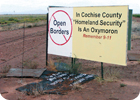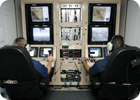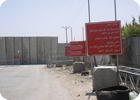
Homeland security, illegal immigration and crime concerns all come together in efforts to better protect the U.S. border. Solutions include physical and electronic methods.
Just before the mid-term elections, President Bush signed legislation authorizing 700 miles of new fencing along the U.S.-Mexico border. It’s believed that the fence may have multiple technologies. “Unfortunately the United States has not been in complete control of its borders for decades and therefore illegal immigration has been on the rise,” Bush said at the signing ceremony.
Also unfortunately, the legislation offers not enough money for the fence project, even in a simple design, as it attempts to cover only one-third of the 2,100-mile U.S.-Mexican border.
While no one knows a final cost if built, a homeland security spending measure earlier this fall allocated $1.2 billion to the fence, only a small fraction of the potential final cost depending on gadgets and widgets. It’s important to realize that even that initial design money can be used for myriad things other than a physical fence, ranging from access roads, vehicle barriers and lighting to high-tech equipment and drone planes. It is estimated that – if the 700-mile fence were to be built – it could cost in excess of $14 billion, depending on the balance of physical and electronic measures.

While physical barriers are one approach, Customs and Border Protection personnel also use security video from fixed and unmanned aerial vehicle locations.
From Bare-bones to High-flying
A bare-bones fence, two rigid, steel-mesh barriers with a paved road between, will cost an estimated $2.2 billion. Critics suggest even that boiled-down plan would cost twice as much based on the overruns in San Diego.San Diego’s 14-mile double fence has been in the works since 1996. But construction of the 15-foot-high, rigid, steel-mesh barrier, which is the model for the proposed 700-mile fence, has been stalled by environmental concerns even though Congress gave the Department of Homeland Security authority to disregard environmental and other laws in an effort to speed the San Diego fence construction.
States also are reacting to border and political concerns.
Earlier this year, for example, Texas Governor Rick Perry announced a “border-patrolling” network of Web Cams on private land. The system was to tie into the Internet and let Texans, or anyone really, “watch” the border and call authorities when they see illegals. That Perry plan has been slow to develop and is a source of some amusement and worry by law enforcement and Customs and Border Patrol officials contacted by Security Magazine. “Think of that false alarm headache,” one sheriff told Security.
Such efforts as fences will slow down a person by a minute or two; intrusion detection alarms and security video won’t do any good if you don’t have the agents to stop them, according to T.J. Bonner, president of the National Border Patrol Council, a union representing Border Patrol agents. Even with pressure on illegal immigration, Customs and Border Protection statistics show that apprehensions at border crossings are down eight percent nationally for the budget year that just ended. Homeland Security officials, on the other hand, believe an electronically enhanced fence would not mean more border patrol officers but the same or even fewer who can concentrate on verified alarms.

Israel has built about 170 miles of the barrier separating it from the Palestinian-dominated West Bank. Another 140 miles are planned or under construction, and 155 more are under review. The barrier, a wire fence in some places and concrete wall in others, has additional enhancements such as barbed wire, electricity, sensors, watchtowers and sniper posts.
Local Resistance
There are also conservation obstacles in building the 700-mile fence. Some naturalists suggest that it would block migration paths for deer, coyotes, mountain lions and other roaming animals, and harm an already vulnerable desert ecosystem. Ironically, some Border Patrol officials suggest the building of more “next-to-the-fence” roads would accelerate drug and illegal trafficking.Some Customs and Border Protection officials, in fact, are pushing for more electronics over physical barriers. “Night-vision cameras, motion detectors, helicopters and unmanned aerial drones are as important as fencing in cutting off illegal border crossings,” a Federal official has been quoted in the media recently.
